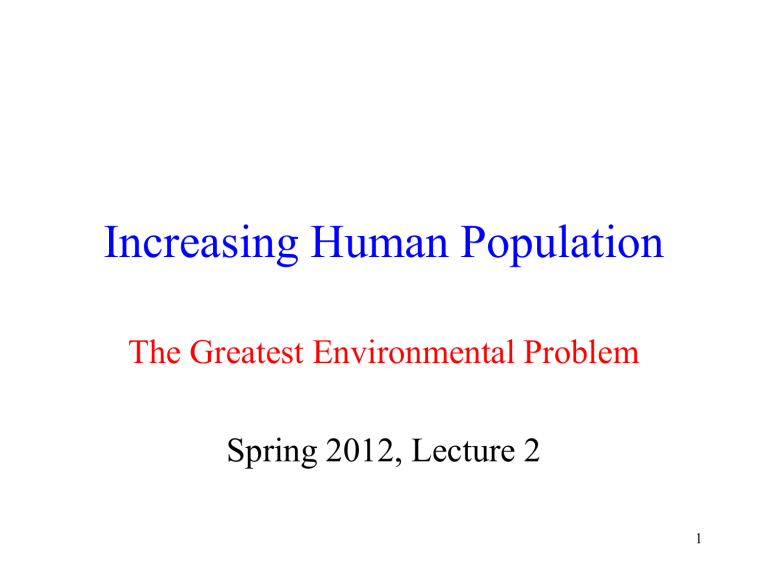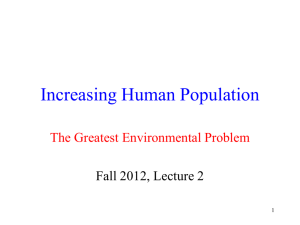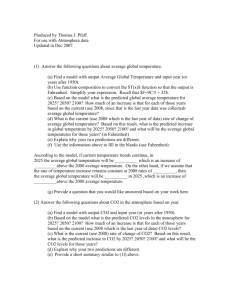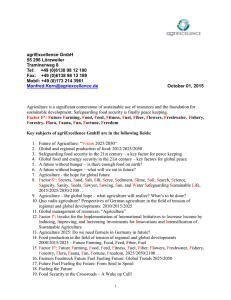Increasing Human Population - FAU

Increasing Human Population
The Greatest Environmental Problem
Spring 2012, Lecture 2
1
US Census Bureau Population
Estimate
Click link below to see Latest Census Bureau
Estimate of U.S. and World Populations
United State Population Clock
World Population Clock
2
3
United Nations Population
Division – 2012 Estimates
Year
1950
1955
1960
1965
1970
1975
Population
2 529 229
2 772 982
3 038 413
3 331 007
3 696 186
4 076 419
1980
1985
1990
1995
2000
In thousands
4 453 007
4 863 290
5 306 425
5 726 239
6 122 770
Year
2005
2010
2015
2020
2025
2030
2035
2040
2045
2050
Population
6 506 649
6 895 889
7 284 296
7 656 528
8 002 978
8 321 380
8 611 867
8 874 041
9 106 022
9 306 128
4
Year of
Estimate
2002
2050 Population Estimates
Low variant Medium variant
7 408 573 8 918 724
High variant
Constant fertility variant
10 633 442 12 753 513
2005
2008
7 679 714 9 075 903
7 958 779 9 149 984
9 306 128 2012 8 112 191
In thousands
10 646 311 11 657 999
10 461 086 11 030 273
10 614 318 10 942 544
5
6
7
Thomas Malthus (1798)
“An Essay on the Principle of Population”
• Populations grow geometrically while supporting resources grow arithmetically
• Population, if not purposefully checked (“preventative checks”), would outpace resources and lead to unplanned
“positive checks” that would return population to sustainable levels
8
Significant Developments and
Human Population
9
Recent Population Explosion
• Detailed look at the last thousand years
10
Crop Yield and Fertilizer Input
“Green revolution”:
• high-yielding crop varieties
• chemical fertilizers
• pesticides
• irrigation
• mechanization
Global Fertilizer use
11
Humans Have:
• Transformed or degraded 39-50% of the
Earth's land surface
• Increased atmospheric CO
2 concentration by
40%
• Overexploited or depleted 22% of marine fisheries
• 44% more are at the limit of exploitation
12
New South Wales, Australia
Figure shows the trend in the total catch for marine fisheries in
NSW since 1984 –85.
13
Changes Due to Man
• About 20% of bird species have become extinct in the past 200 years, almost all of them because of human activity
• Man uses more than half of the accessible surface fresh water
• On many islands, more than half of plant species have been introduced by man
• On continental areas, man has introduced 20% or more of the plant species present
14
Human Activities
• Over 50% of terrestrial nitrogen fixation is caused by human activity
• Use 8% of the primary productivity of the oceans (25% for upwelling areas and 35% for temperate continental shelf areas)
15
Changes Due To Man
16
Population and Availability of
Renewable Resources
1990 2010
Total
Change (%)
Per Capita
Change (%)
Population (millions)
Fish Catch (million tons)
Irrigated Land
(million hectares)
Cropland (million hectares)
5,290 7,030 33
85 102 20
237 277
1,444 1,516
17
5
-10
-12
-21
Rangeland and Pasture
(million hectares)
3,402 3,540 4 -22
Forests (million hectares) 3,413 3,165 -7
Source: Postel, S. "Carrying capacity: Earth's bottom line." State of the World, 1994.
-30
17
Regional population patterns:
Population density
Consortium for International
Earth Science Information Network.
18
Doubling Times
World
Africa
Kenya (fastest)
Latin America
Asia
40 years
23 years
20 years
30 years
36 years
19
Doubling Time Map - 2000
20
Worldwide Fertility, 2005
• Children per woman 21
Reduction in Childhood Death
Rates
• DDT used against mosquitoes that transmit malaria
• Childhood immunization used against cholera, diphtheria, etc.
• Antibiotics used against bacterial infections
22
Demographic Transitions
•
When a country moves from stage 1 of the demographic model to stage 2, a population explosion occurs
• This transition occurs when technology and medical care improvements decrease a countries death rate dramatically while the birth rate stays the
23 same; this causes the natural rate of increase to increase rapidly
Demographic Transition -Sweden
“Rate of Natural Increase”
24
Demographic Transition -Mexico
“Rate of Natural Increase”
25
National Age Structures
• The proportion of individuals in different age groups has a significant impact on the potential for future population growth
• Mexico – large fraction of young people likely to reproduce in the near future
• Sweden – even distribution of population through all age groups, and many people beyond prime reproductive years
• United States – even distribution except for bulge due to post WWII baby boom
26
Age Structures
• Each horizontal bar is a five-year cohort
• Blue = pre-reproductive, yellow – reproductive, and orange – postreproductive
27
People over 100 years old in U.S.
4,000 in 1970
28
People over 100 years old in U.S.
• 79,086 in 2010
29
People over 100 years old in U.S.
Projected 597,547 thousand in 2050
30
31
Trends in U.S. Population
32
2008 Population Projections
33
Global Income Distribution, 1960 - 1989
Share of Global Income Going To:
Year
1960
1970
1980
1989
Richest 20% Poorest 20 % Ratio of richest to poorest
70.2
2.3
30 to 1
73.2
76.3
82.7
2.3
1.7
1.4
32 to 1
45 to 1
59 to 1
Source: United Nations Development Programme, Human
Development Program, 1992 (New York, Oxford University Press,
1992) 34
Global Income
Distribution Graphic
35
Global Wealth Pyramid, 2011
36
Food Distribution Animation http://vimeo.com/moogaloop.swf?clip
_id=8812686
37
China - 20% of world’s population
• Potential for rapid population growth
• 2000: 1,263,637,531
38
China: "one-child-per-couple" policy since 1979
• Rewards for having only one child: grants, additional maternity leave, increased land allocations. Children get preferential treatment in education, housing, and employment.
• Couples punished for refusing to terminate unapproved pregnancies, for giving birth when under the legal marriage age, and having an approved second child too soon.
• Penalties include fines, loss of land grants, food, loans, farming supplies, benefits, jobs and discharge from the
Communist Party.
• In many provinces sterilization is required after the couple has had two children.
39
China’s Population Policy
Children per woman:
1970: 5.01
1995: 1.84
Population still growing!
Population in 2000: 1.3 billion
Projected for 2025: 1.5 billion
Criticisms:
Use of abortion
Forcible abortions and sterilization
Infanticide
40
China 2025
• Approaching stabilization
• 2025: 1,394,638,699
41
China 2050
• Possible decline in population
• 2050: 1,303,723,332
42
India
2000: 1,006,300,297
43
India 2025
• 2025 predicted: 1.396.046.308
• The base is narrower than the top
44
India 2050
• 2050 predicted: 1,656,553,632
• A definite “baby-boom” shape
• Note disparity male/female numbers
45
U.N. Conference on Population (Cairo, 1994)
"Programme of Action" (182 nations)
Goal: to stabilize human population at 7.8 billion by 2050
1. Provide universal access to family-planning and reproductive health programs.
2. Recognize that environmental protection and economic development are not necessarily antagonistic. Promote free trade, private investment and development assistance.
3. Make women equal participants in all aspects of society - by increasing women's health, education, and employment.
4. Increase access to education. Provide information and services for adolescents to prevent unwanted pregnancies, unsafe abortion, and the spread of AIDS and sexually transmitted diseases.
5. Ensure that men fulfill their responsibility to ensure healthy pregnancies, proper child care, promotion of women's worth and dignity, prevention of unwanted pregnancies, and prevention of the spread of AIDS and sexually
46 transmitted diseases.
United Nations Population Fund
(UNFPA)
Programs to improve:
• Pre- and post-natal mother's health
• Access to voluntary family planning programs and contraception
• STD and HIV education and prevention
• U.S. funding withheld for many years because of
UNFPA’s support of China’s policies
• U.S. funding restored for F.Y. 2000 at level of $25 million
47
Slowing Population Growth
• The HIV epidemic is measurably slowing population growth
• Nowhere is this more evident than in sub-Saharan
Africa, a region of 800 million people, where the epidemic is spiraling out of control
• If a low-cost cure is not found soon, countries with adult HIV infection rates over 20 percent, such as
Botswana, South Africa, and Zimbabwe, will lose one fifth or more of their adult population to AIDS within the next decade
48
Slowing Population Growth
• When the United Nation's demographers did their biennial update of world population numbers and projections in October of 1998, they reduced the projected global population for 2050 from 9.4 billion to 8.9 billion – in 2009, it is 9.1 billion
• Of this 500 million drop, two thirds was because of falling fertility - that's the good news
• The bad news is that one third of the fall was the result of rising mortality from AIDS
49









